
AV Case Study: Handa Opera on Sydney Harbour
How Riedel Communications’ technology keeps the show going amid the harsh conditions of Sydney Harbour.
Text:/ Graeme Hague
Here’s an idea. How about building an expansive, open air stage – no roof – suspended over the water of one of the world’s busiest saltwater harbours, schedule a major production for four weeks over March-April to ensure the weather will be fickle, and then perform large-cast iconic operas including a live orchestra to sell-out audiences of 3000 people seated in grandstands you also had to build along with all the other prerequisite facilities such as restaurants, bars and bathrooms.
What could possibly go wrong?
A lot, obviously. However, because the production crew of Opera Australia’s Handa Opera on Sydney Harbour (HOSH) are consummate professionals, and HOSH partners with equally accomplished companies – in particular here, Riedel Communications – the show always goes on and has been an outstanding success since its inception in 2012. Billed as an ‘all weather event’, HOSH has annually presented operas and musicals such as, among others, Madama Butterfly, West Side Story, and of course the near-obligatory Phantom of the Opera. The latest to grace the stage this year was Guys and Dolls. These productions are lavish and spectacular, and a testament to the complex theatre craft and technology going on behind the scenes that faces enough challenges without having to worry about inadvertently slipping beneath the waves of Sydney Harbour.
An important fact to make clear; for nine months of the year the HOSH location is little more than a largish public park next to the waterside – even the pylons aren’t installed. It’s not just the staging and FOH towers that are constructed for the events. The entire site is created including grandstand seating, café, bars, security, facilities… it’s like some giant pop-up amphitheatre, or maybe an enormous, travelling circus sans any wild animals – well, aside from the camels they used in Aida (yes, camels) and for some reason without any tent over the stage.
CONNECTING EVERYTHING TO EVERYTHING
With this sprawling and multi-faceted production, reliable communication throughout the site is essential. Again, it’s not just about the audio FOH telling one of the stage crew to swap out a dead battery. The data/comms network linking the Audio and Lighting FOH to the stage also handles everything, and ranges from exactly that kind of performance-critical battery scenario to providing internet access to EFTPOS machines in the bars, and maintaining solid CCTV security everywhere, and keeping the myriad ground staff in contact and informed. So, while we’re used to regarding the audio and LX control positions as the Mecca of any show, at HOSH the Comms Room is definitely of equal if not greater importance. You might think it’s folly to not have more segregation between show comms and the service/facilities side of things, but that’s the beauty of Riedel Communications’ network design and the proprietary equipment, developed and built by Riedel, deployed for the gig. You get the best of both worlds – a network that encompasses everything and provides total control from a single point, and yet it provides clear separation and tight zones where they’re needed. Central to this are eighteen 2300 Series and three 1200 Series Riedel SmartPanels and Artist Intercom systems which integrate seamlessly to allow plenty of options at the operators’ fingertips yet remain a single, cohesive communications network.
Riedel was brought on board in 2021 – nautical metaphors are a must – when Opera Australia acknowledged that dedicated expertise for comms was needed. Roo Smith, Riedel’s Senior Project Manager, had been involved with this event in a similar capacity for almost a decade before shifting across to Riedel. Production Manager Pablo Puig joined the team in 2013. Meaning, Roo and Pablo go back a long way and have plenty of stories to tell. They’ve seen the evolution of HOSH over more than a decade and how much the comms requirements have grown in that time.
Roo tells us, “In all, this year we had around 100 personal comms operating during every performance. That includes the two-way radios used by people like security and house staff, some dedicated wired, digital PunQtum body-packs for the six follow-spot crew (Robospots operated remotely from beneath the grandstand) and Bolero wireless body-packs for the majority of the actual stage crew.” Added to these were the various audio and lighting FOH teams, the Stage Manager, and the Musical Director – the usual suspects in every theatrical production.
“The Boleros are really tough,” says Roo, admitting they get a bashing in this environment and being wireless units, you’d expect some sort of attrition. “We’ve never lost one. They just keep working.”
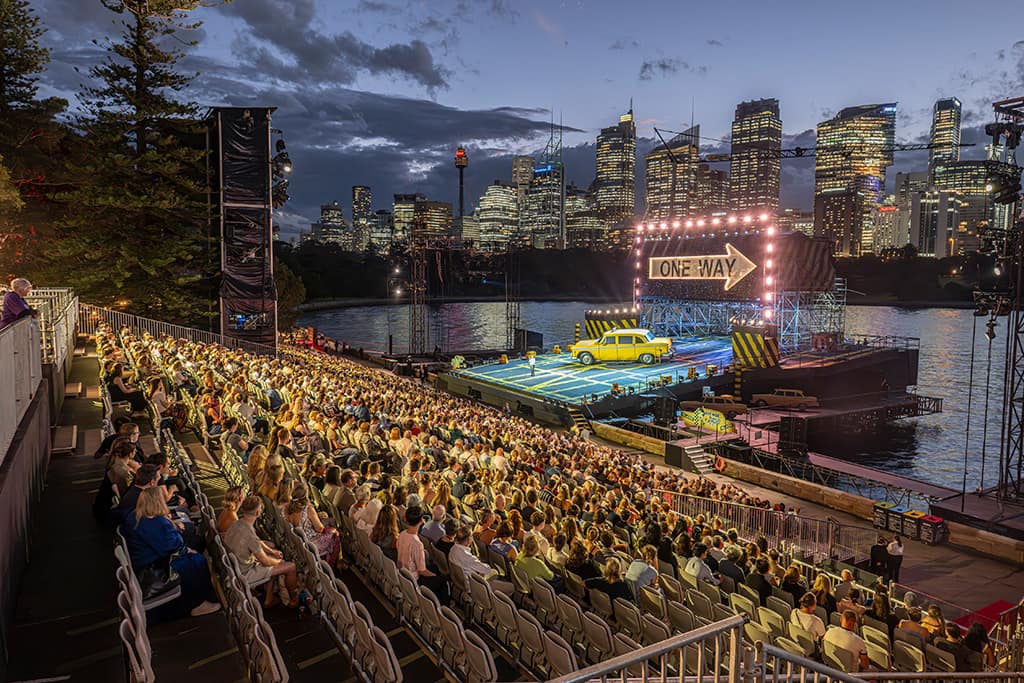
NOT JUST A PIPE DREAM
The logistics of HOSH are impressive – or frightening, depending on your point of view. The whole shebang is put together in four weeks, from dropping in the pylons to opening night. The stage is what traditionalists call ‘raked’, meaning slightly raised at the rear to provide clear site lines for the audience, and the entire structure is high enough to house underneath control points (Stage Manager, for example) dressing rooms, storage and bathrooms including toilets. On shore, beneath the grandstand seating is also home to a host of crucial equipment that doesn’t necessarily need to be on or under the stage – including the Comms Room – and above these is the scaffold tower for FOH operations.
Data from the stage to shore is via very armoured fibre cabling (more on that in a moment) and through a tunnel somewhat delicately referred to as ‘the poo pipe’ because it also contains the sewerage piping from the stage toilets and into Sydney’s water treatment system – which ironically eventually ends up in the ocean anyway, so why bother? Just cut a hole in the decking.
But back to those logistics…
Pablo admits, “It’s a tight schedule, and of course we have dress rehearsals and technical runs, but some components of the production aren’t in place until opening night. It’s a well-calculated risk with equipment we’re familiar with using.”
It’s another advantage to Riedel being responsible for all the network and associated cabling. Instead of the different departments of audio, lighting, comms and staging all running their own cables, Riedel’s design allows for everyone to share its fibre and connection points and significantly reduce setup times for everyone, not to mention multiple piles of coiled or figure-eight cabling at every position.
DO YOU SEE WHAT I SEE?
In 2022, Opera Australia asked Riedel to also take on the site’s CCTV network. Pablo explains, “We have usually 20 CCTV cameras around the entire site and they’re especially vulnerable to the conditions. By the end of the season, we’d be down to about 10 or so. Riedel came up with a more reliable CCTV system which is, of course, also part of the whole site network.”
The CCTV cameras are used for security and crowd monitoring – the latter not so much in an intrusive way, but more as a practical method to observe the large areas surrounding the stage. Pablo says, “If we have a medical emergency in the audience, or any kind of issue that needs locating fast, the CCTV is the best find out what’s going on and guide staff to help.” The system can be accessed remotely, and a few years back, after a violent overnight storm, Pablo was able to assess the damage to the stage from his home before arriving on site. And therefore, keep a cool and calm demeanour.
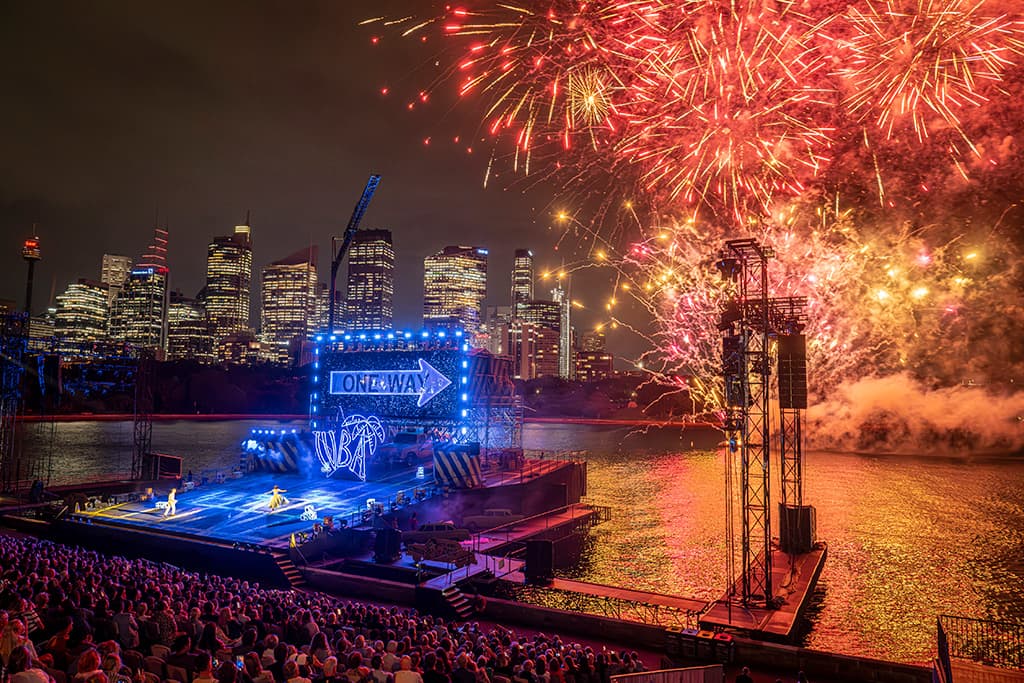
SO, WHAT CAN GO WRONG?
To answer this, Roo Smith got to go first. “Oysters,” he says. The crew food rider? Sounds a bit ungrateful. No, in fact it’s oysters and barnacles. It’s why the fibre connection between the stage and dry land has to be seriously armoured because there are sections which unavoidably come into contact with the sea wall and the pylons which are encrusted with razor-sharp oyster shells and barnacles. And even in the relatively short period of time HOSH is up and running, fresh barnacles will latch onto anything given the opportunity.
Pablo’s response is a little more predictable. “The weather,” he says. “And the environment in general.” Which makes sense, but when you look at the problem closer, it’s more than your average outdoor production has to deal with. Any kind of wind can whip salt-laden mists across the stage, and the local ferries smashing past through any sort of swell don’t help either. Added to this, the Sydney weather often triggers a heavy condensation under the stage and grandstands, also threatening the equipment with pervasive and corrosive moisture. Pooling water is another constant problem. Roo tells us, “We’ve learned that nothing can be on the floor or decking. Everything has to be on road case wheels or blocked up – anything it takes to keep the gear off the ground.”
Has the system ever broken down? Roo tells the story, “We had one occasion when almost all the radios and comms stopped working – it was bizarre and had us completely tricked for a while. It turned out to be the local Sydney Water Police trialling some new Wi-Fi jamming equipment.”
Which raises the question of how a production that relies on so much wireless comms manages to operate in an area incredibly crowded with spurious RF from every angle. The solution is provided by Riedel’s designs – the Boleros especially – having exceptional ability to seamlessly ‘frequency hop’ as soon as any interference is detected. Added to this, Riedel has also deployed a trunked radio system, expanding the two-way radio coverage and flexibility and allowing the number of transmissions to be more than halved, meaning more space for other show-critical devices such as radio mics and IEMs – Riedel has licensed a collection of frequencies for its exclusive use. The bottom line being that RF bleed from outside sources is rarely encountered.
MORE THAN A PARTNERSHIP
The relationship between Opera Australia and Riedel Communications has long since become a lot more than a client/service provider partnership. They’ve melded into a solid team and Pablo can’t overstate just how much Opera Australia appreciates the level of service and professionalism brought to the production by Riedel. Nothing is too much to ask, every challenge is tackled with enthusiasm, and problems are always cheerfully solved. Sometimes, solutions are found before anyone realised something needed doing. Recently, Roo Smith handed over most of the coalface responsibilities to Jess Murphy whose contribution to the project has been invaluable.
BRING IT ON
No surprise, much of the preparation for HOSH takes place many months ahead of the season. Every production is a year-long project that culminates in the month of performances, then there’s a short break before everybody is back at the drawing boards and planning the next – and always striving to do things bigger, better and brighter than before. The team from Opera Australia and Riedel Communications put their heads together again to make it all happen and achieve a spectacular event, and something special in the world of opera and performing arts.
HOSH: opera.org.au/sydney/opera-on-sydney-harbour
Riedel Communications: riedel.net


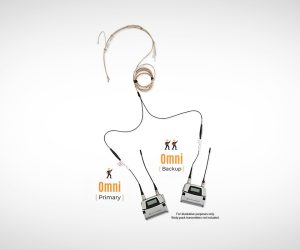
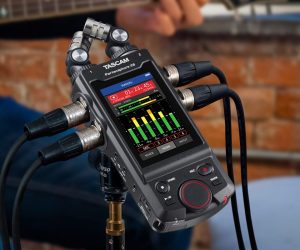




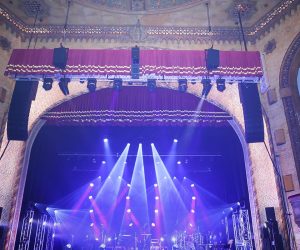






RESPONSES